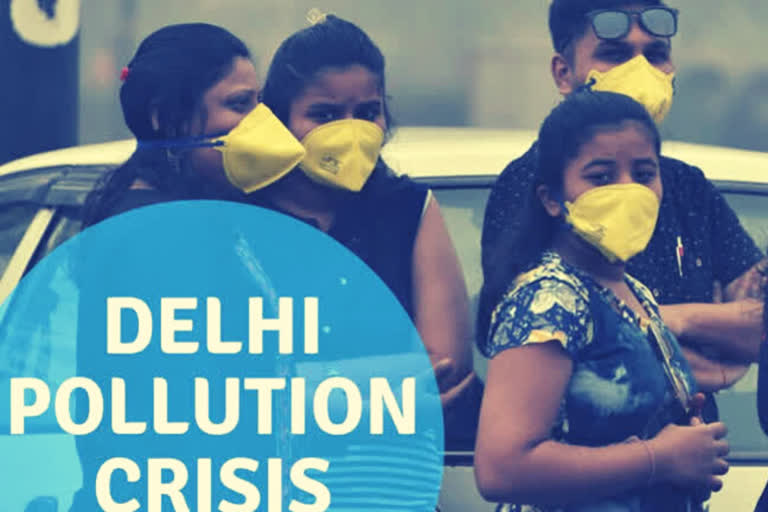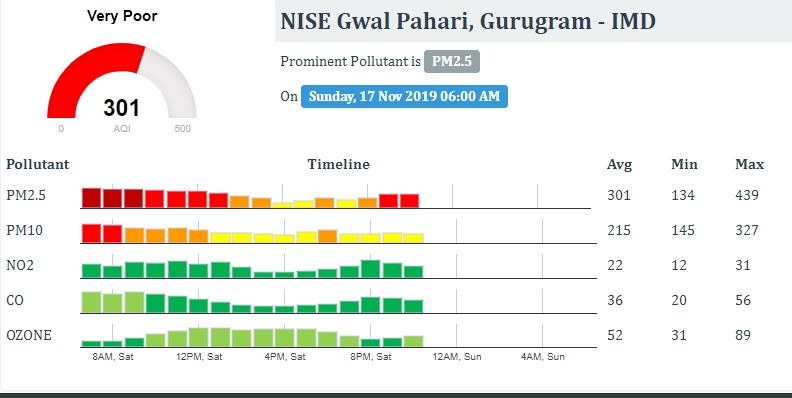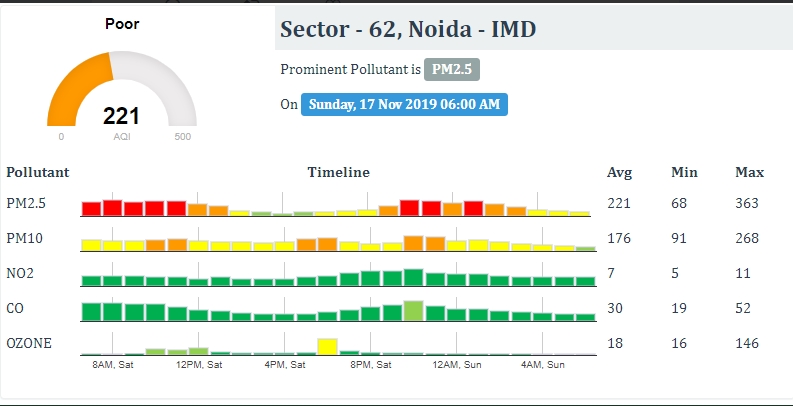Delhi Chief Minister Arvind Kejriwal wrote on twitter, "A very strong correlation can be seen between stubble burning and the spike in air pollution in North India. As soon as stubble burning began in the first week of Oct, the AQI started rising. Now that burning is coming to an end, air quality is also improving."
Delhi-NCR pollution UPDATES: Air quality remains 'poor'

12:03 November 17
-
A very strong correlation can be seen between stubble burning and the spike in air pollution in North India. As soon as stubble burning began in the first week of Oct, the AQI started rising. Now that burning is coming to an end, air quality is also improving.. https://t.co/0RopC2Al5x
— Arvind Kejriwal (@ArvindKejriwal) November 17, 2019 " class="align-text-top noRightClick twitterSection" data="
">A very strong correlation can be seen between stubble burning and the spike in air pollution in North India. As soon as stubble burning began in the first week of Oct, the AQI started rising. Now that burning is coming to an end, air quality is also improving.. https://t.co/0RopC2Al5x
— Arvind Kejriwal (@ArvindKejriwal) November 17, 2019A very strong correlation can be seen between stubble burning and the spike in air pollution in North India. As soon as stubble burning began in the first week of Oct, the AQI started rising. Now that burning is coming to an end, air quality is also improving.. https://t.co/0RopC2Al5x
— Arvind Kejriwal (@ArvindKejriwal) November 17, 2019
07:50 November 17

Gurugram: The Air Quality Index (AQI) showed improvement and was recorded at an average of 301 at NISE Gwal Pahari area in Gurugram on Sunday morning, as per the Central Pollution Control Board (CPCB) data. The air quality at this level falls under a 'very poor' category.
The AQI in Gurugram was 360 as per the CPCB on Saturday, which was an improvement from the 'severe plus' category on Friday.
Gurugram residents struggled for clean air as the AQI docked at 703, which falls in the 'severe plus' category, as per the data from Air Quality and Weather Forecasting And Research (SAFAR).
07:50 November 17

Noida: According to data provided by the Central Pollution Control Board (CPCB), the Air Quality Index (AQI) at Sector 62 Noida docked at 221, which falls in the 'poor' category. The current AQI is down from 573 (severe) that was recorded on Saturday.
Isolated pockets of the region were covered in a thick blanket of smog due to the spike in pollutants in the air. The smog cover also reduced visibility at major junctions of the city in the wee hours.
07:31 November 17
New Delhi: The overall air quality in Delhi continued to remain in 'very poor' category for the second consecutive day on Sunday, according to System of Air Quality and Weather Forecasting And Research (SAFAR).
The overall Air Quality Index (AQI) in the national capital was recorded at 365 which falls under 'very poor' category. The AQI between the range of 51 to 100 is considered as satisfactory; 101-200 is moderate; 201-300 falls under the category of poor. While 300-400 is considered as 'very poor', levels between 401-500 fall under the 'hazardous category'.
The AQI recorded in Lodhi Road in Delhi was 218 (PM 2.5) and 217 (PM 10) on Sunday morning. Mathura Road recorded a figure of 304, IIT Delhi docked at 324 and Airport Terminal 3 at 315.
The spike in air pollution in the national capital is primarily due to insufficient rainfall and low wind speed.
Residents of Delhi have been badly affected by the poor air quality.
Locals especially the middle-aged people complained of breathless and fatigue and have urged the government to take requisite measures to combat the menace.
According to a cardiologist at Ram Manohar Lohia Hospital, Dr Tarun, there has been a 10-15 per cent rise in patients suffering from cardiovascular disease in the past few days after Delhi's air pollution levels rose sharply.
"People should remain indoors and increase uptake of anti-oxidants which are found in abundance in fruits. Whenever one has to go out then the usage of N95 mask is mandatory because it is the only mask that protects from PM pollution. People should improve the environment at the homes by having some plants like money plant, snake plant, etc. Finally, if it is affordable then air purifiers should be used in the homes," the doctor added.
During the winter season each year, most of Northern India suffers from a spike in toxicity in the air due to the change in weather and crop residue burning in the neighbouring states of Haryana, Punjab and Uttar Pradesh.
Also read: Delhi! Devoid of clean water, pure air
12:03 November 17
-
A very strong correlation can be seen between stubble burning and the spike in air pollution in North India. As soon as stubble burning began in the first week of Oct, the AQI started rising. Now that burning is coming to an end, air quality is also improving.. https://t.co/0RopC2Al5x
— Arvind Kejriwal (@ArvindKejriwal) November 17, 2019 " class="align-text-top noRightClick twitterSection" data="
">A very strong correlation can be seen between stubble burning and the spike in air pollution in North India. As soon as stubble burning began in the first week of Oct, the AQI started rising. Now that burning is coming to an end, air quality is also improving.. https://t.co/0RopC2Al5x
— Arvind Kejriwal (@ArvindKejriwal) November 17, 2019A very strong correlation can be seen between stubble burning and the spike in air pollution in North India. As soon as stubble burning began in the first week of Oct, the AQI started rising. Now that burning is coming to an end, air quality is also improving.. https://t.co/0RopC2Al5x
— Arvind Kejriwal (@ArvindKejriwal) November 17, 2019
Delhi Chief Minister Arvind Kejriwal wrote on twitter, "A very strong correlation can be seen between stubble burning and the spike in air pollution in North India. As soon as stubble burning began in the first week of Oct, the AQI started rising. Now that burning is coming to an end, air quality is also improving."
07:50 November 17

Gurugram: The Air Quality Index (AQI) showed improvement and was recorded at an average of 301 at NISE Gwal Pahari area in Gurugram on Sunday morning, as per the Central Pollution Control Board (CPCB) data. The air quality at this level falls under a 'very poor' category.
The AQI in Gurugram was 360 as per the CPCB on Saturday, which was an improvement from the 'severe plus' category on Friday.
Gurugram residents struggled for clean air as the AQI docked at 703, which falls in the 'severe plus' category, as per the data from Air Quality and Weather Forecasting And Research (SAFAR).
07:50 November 17

Noida: According to data provided by the Central Pollution Control Board (CPCB), the Air Quality Index (AQI) at Sector 62 Noida docked at 221, which falls in the 'poor' category. The current AQI is down from 573 (severe) that was recorded on Saturday.
Isolated pockets of the region were covered in a thick blanket of smog due to the spike in pollutants in the air. The smog cover also reduced visibility at major junctions of the city in the wee hours.
07:31 November 17
New Delhi: The overall air quality in Delhi continued to remain in 'very poor' category for the second consecutive day on Sunday, according to System of Air Quality and Weather Forecasting And Research (SAFAR).
The overall Air Quality Index (AQI) in the national capital was recorded at 365 which falls under 'very poor' category. The AQI between the range of 51 to 100 is considered as satisfactory; 101-200 is moderate; 201-300 falls under the category of poor. While 300-400 is considered as 'very poor', levels between 401-500 fall under the 'hazardous category'.
The AQI recorded in Lodhi Road in Delhi was 218 (PM 2.5) and 217 (PM 10) on Sunday morning. Mathura Road recorded a figure of 304, IIT Delhi docked at 324 and Airport Terminal 3 at 315.
The spike in air pollution in the national capital is primarily due to insufficient rainfall and low wind speed.
Residents of Delhi have been badly affected by the poor air quality.
Locals especially the middle-aged people complained of breathless and fatigue and have urged the government to take requisite measures to combat the menace.
According to a cardiologist at Ram Manohar Lohia Hospital, Dr Tarun, there has been a 10-15 per cent rise in patients suffering from cardiovascular disease in the past few days after Delhi's air pollution levels rose sharply.
"People should remain indoors and increase uptake of anti-oxidants which are found in abundance in fruits. Whenever one has to go out then the usage of N95 mask is mandatory because it is the only mask that protects from PM pollution. People should improve the environment at the homes by having some plants like money plant, snake plant, etc. Finally, if it is affordable then air purifiers should be used in the homes," the doctor added.
During the winter season each year, most of Northern India suffers from a spike in toxicity in the air due to the change in weather and crop residue burning in the neighbouring states of Haryana, Punjab and Uttar Pradesh.
Also read: Delhi! Devoid of clean water, pure air


